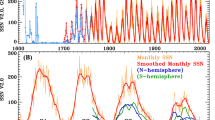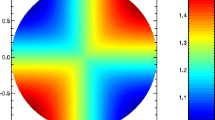Summary
Lunar and luni-solar geomagnetic components have been computed upto four harmonics for low latitude station Alibag, outside equatorial electrojet belt, and the equatorial electrojet stations Annamalainagar, Kodaikanal and Trivandrum in the south Indian region. The computations are confined to data of very high solar activity period 1958–61. Amplitudes of lunar semidiurnal component (L 2), in the horizontal intensity (H), undergo an equatorial enhancement. Phase difference of 2 hrs is noticed inL 2 (H) between nonelectrojet and electrojet stations. In the vertical intensity (Z), L 2 is maximum ine andj-seasons at Trivandrum, close to the magnetic equator. Ind-season, however, maximumL 2 (Z) occurs at Annamalainagar (dip 5°.4N). The phase difference between the electrojet and nonelectrojet stations observed inL 2 (H) is not noticed inL 2 (Z). The differential vertical upward drift motion of charged particles may explain the observed phase difference inL 2 (H). Seasonal variations in amplitudes and times of maxima are noticed at all the stations inL 2 (H) andL 2 (Z). Similar variation is also noticed at Alibag inL 2 of declination (D).
Similar content being viewed by others
References
J. Bartels, Z. Geophys.12 (1936), 368.
C. A. Onwumechilli andN. S. Alexander, J. Atmosph. Terr. Phys.16 (1959), 115.
K. S. Raja Rao, Indian J. Met. Geophys.13 (1962), 97.
R. G. Rastogi, J. Atmosph. Terr. Phys.30 (1968), 497.
R. G. Rastogi andN. B. Trivedi, Planet. Space Sci.18 (1970), 367.
S. Matsushita,Lunar Tides in the Ionosphere (Encyclopedia of Physics, Handbuch der Physik).
K. K. Tschu, Australian J. of Sci. Res. [A],2 (1949), 1.
S. Chapman andJ. C. P. Miller, Monthly Not. of R. A. S. Geophysical Supplement,4 (1940), 649.
J. Bartels andG. Fanselau Terr. Mag. and Atmosph. Elec.43 (1938), 155.
S. R. Malin andS. Chapman, The Geophys. J. of R.A.S.19, 1 (1970), 15.
B. R. Leaton, S. R. Malin andH. F. Finch, Royal Observatory Bulletins, No. 63 (1962).
J. Egedal, L'Institut Météorologique Danois, Communications Magnétiques, etc. No. 22 (1956).
K. S. Raja Rao, J. Geophys. Res.65 (1960), 119.
J. C. Gupta andS. Chapman Manual of the Coefficients of the first four harmonics of the solar and lunar daily variations computed from IGY/C and Certain other data. (High Altitude Observatory, NCAR, Boulder, Colorado, Publication.)
W. D. Baker andD. F. Martyn, Phil. Trans. Roy. Soc. London, Ser. [A]246 (1953), 281.
S. Matsushita, J. Geomag. Geoelec.7 (1955), 91.
S. Matsushita, J. Atmosph. Terr. Phys.10 (1957), 163.
C. A. Onwumechilli, J. Geophys. Res.65 (1960), 3433.
Author information
Authors and Affiliations
Rights and permissions
About this article
Cite this article
Rao, D.R.K. Lunar and luni-solar variations of the geomagnetic field in the Indian region. PAGEOPH 95, 131–140 (1972). https://doi.org/10.1007/BF00878861
Received:
Issue Date:
DOI: https://doi.org/10.1007/BF00878861




